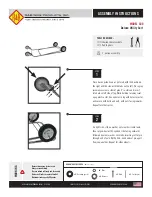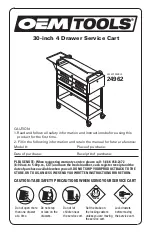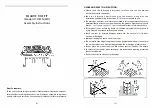
4
1. Distilled water is always recommended to fill your fountain. Distilled water is pure and should have no minerals or sediment in it. It will extend the
life of the pump and the time between cleanings. If distilled water is not an option, use filtered water, as water directly from your tap will generally
have minerals and chemicals that can build up and leave behind residue on your fountain.
2. Check the water level regularly to ensure the pump is completely submerged during operation. This is necessary ensure proper cooling of the
pump and prevent overheating. In summer months, or dry, hot climates, water evaporates very quickly, so it may be necessary to check the water
level every day. The rate of water evaporation will also be greater with larger fountains, with more surface area, than smaller fountains.
3. Keep the fountain water and pump clean and clear of debris. If placed under a tree or near vegetation, you may need to scoop out leaves and
other debris every other day. Water treatments that prevent algae growth and mineral deposits are available at your local home & garden stores.
Do not use bleach as it may be harmful to pets and wildlife and may also damage the finish of the fountain.
4. Clean the fountain monthly to prevent mineral deposits and contamination which may clog the pump.
Disconnect the pump from the power source and empty the water from the fountain. Use any gentle household cleanser and a soft brush or cloth
to clean the fountain. Avoid using any harsh chemicals, abrasives or rough scrubbing, as this could damage the finish on your fountain. The
frequency of cleaning may vary depending on the location of your fountain.
5. Use a pre-filter on your pump if available to prevent it from clogging with leaves or other debris.
6. Regular cleaning of the pump will be necessary depending upon the environment in which it is operated. Clean the pump when it is visibly soiled
or when a noticeable decrease in performance is detected. Failure to clean the pump will result in overheating of the pump. .
7. Before cleaning, always disconnect the pump from the power source.
8. Disassemble the pump by removing the filter and regulator/impeller plate. Remove the impeller/rotor assembly by gently pulling on the impeller
blades. Use a soft cloth or brush to clean the area inside of the pump housing. Clean the filter, gland and impeller in warm soapy water.
Reassemble the pump and inspect for proper operation. Please see the diagram which matches your pump below:
9. Although it is not required, pumps generally last longer if left running continuously as it reduces the wear from starting and stopping. However,
running the pump continuously will also use a little more electricity, and will require you to refill the fountain more frequently. If mosquitoes are a
problem in your area, it is recommended to run the fountain as much as possible to prevent standing water, where mosquitoes breed. You may
also add a few drops of anti-mosquito water treatment, available at your local home and garden store, to the fountain water
10.Place the fountain in a location that will not be damaged should the area come in contact with liquids.
11. To eliminate water damage to floors and/or surrounding fountain areas, check for leaks and excessive splashing after initial installation and on a
regular basis.
12.If your fountain develops a leak and a visible crack is detected, plastic epoxy or Clear Silicone II sealant may be used to seal it. If the fountain
leaks without a visible crack, turn the pump off, fill the fountain and let the fountain sit for one week. If there is a crack, it will appear white.
Remember to keep the water ¾ full as will evaporate over time. Seal the leak with plastic epoxy or Clear Silicone II sealant.
13.If the fountain is not in use for an extended period of time, disconnect the power and empty all the water from the fountain. Do not tip the fountain
to empty the water. Use a siphon pump or a small bucket.
14.The fountain should not be operated in temperatures below 41° Fahrenheit / 5° Celsius to prevent frost damage. During winter months, before the
temperature hits freezing, disconnect the power, drain your fountain and store it in a heated area. If the fountain is stored outdoors in freezing
temperature, disconnect the power, empty all the water from the fountain, remove the pump and any lights if possible, make sure it is completely
dry and cover it with a tarpaulin. Any water left in the fountain may freeze and expand causing the fountain to crack. .
15.If your fountain is equipped with an independent light set, you can use an outlet timer to have the lights activate during night time hours. Please
note, on some models the lights cannot be operated independently from the pump so the lights are on, when the pump is on.
TROUBLESHOOTING GUIDE
If the pump does not operate…
1. Check to make sure the pump is connected to a power source.
2. Check the water level to ensure the pump is completely submerged. Add water as needed.
If the pump operates, but, there is no water flow…
1. Check the water level to ensure the pump is completely submerged. Add water as needed.
2. Check the supply tube for any kinks or folds and correct.
If the pump operates, but there is no water flow and the pump is fully submerged and the supply tubing has no kinks…
1. Disconnect the pump from the power source.
2. Disconnect the supply tube from the pump outlet.
3. Check for clogs or holes and clean the tubing inside and outside if necessary.
4. Check for clogs and clean the pump inlets and outlet if necessary.
5. Place the pump back into the water outlet side up and then re-connect the pump to the power source.
6. Once the water begins to flow from the pump, re-connect the supply tubing to the pump outlet.
7. Check for any air trapped in the water supply tube which may prevent the pump from working.
If the pump runs with low or high water circulation…
1. Check and adjust the regulator dial or slide on the front of the pump. Adjust the dial/slide towards (+) to increase water flow or towards (-) to
decrease water flow.
If the pump operates, but the water flow is uneven or non existent and the pump makes noise…
1. Check the impeller assembly for wear. Remove the front cover and regulator/impeller plate and remove the impeller assembly. Clean the
impeller assembly and inspect for wear. If the rotor spins freely from the magnetic body, the impeller assembly is worn and needs to be replaced.
Contact customer service for replacement parts.
If the pump starts to make noise…
1. Check the water level to ensure the pump is completely submerged. If the water level drops below the pump intake, it may suck in air and cause
the noise or the pump to completely stop working.
2. Move the pump away from the sides of the basin or place a piece of foam or sponge underneath the pump to isolate any vibration which causes
the noise.
If the water starts to foam…
1. Check the water level to ensure the pump is completely submerged. If the water level drops below the pump intake, it may suck in air and cause
the pump to ‘spit’ and foam the water.
2. Add a few drops of anti-foaming water treatment, available at your local home and garden store, to the fountain water.























